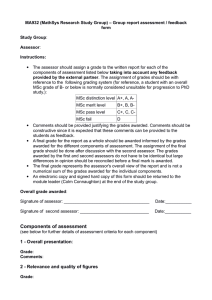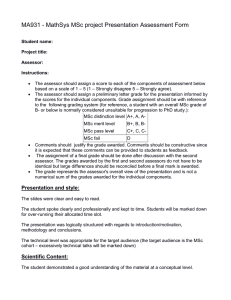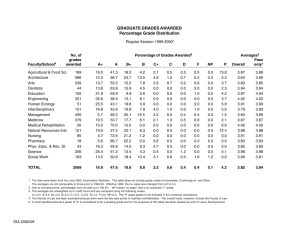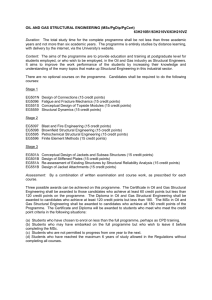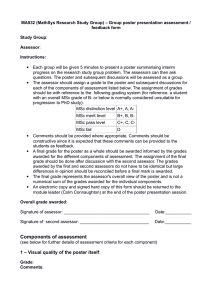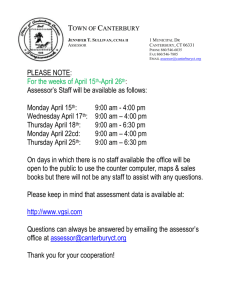– report assessment / feedback form MathSys/Erasmus Mundus Research Project
advertisement
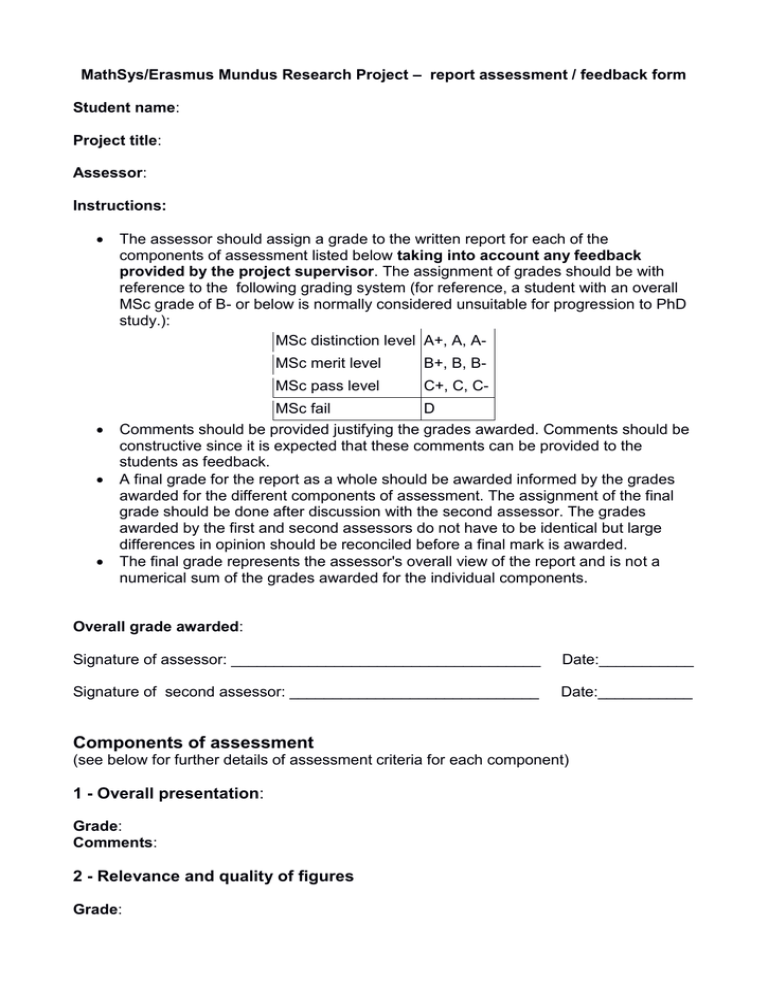
MathSys/Erasmus Mundus Research Project – report assessment / feedback form Student name: Project title: Assessor: Instructions: The assessor should assign a grade to the written report for each of the components of assessment listed below taking into account any feedback provided by the project supervisor. The assignment of grades should be with reference to the following grading system (for reference, a student with an overall MSc grade of B- or below is normally considered unsuitable for progression to PhD study.): MSc distinction level A+, A, AMSc merit level B+, B, B- MSc pass level C+, C, C- MSc fail D Comments should be provided justifying the grades awarded. Comments should be constructive since it is expected that these comments can be provided to the students as feedback. A final grade for the report as a whole should be awarded informed by the grades awarded for the different components of assessment. The assignment of the final grade should be done after discussion with the second assessor. The grades awarded by the first and second assessors do not have to be identical but large differences in opinion should be reconciled before a final mark is awarded. The final grade represents the assessor's overall view of the report and is not a numerical sum of the grades awarded for the individual components. Overall grade awarded: Signature of assessor: ____________________________________ Date:___________ Signature of second assessor: _____________________________ Date:___________ Components of assessment (see below for further details of assessment criteria for each component) 1 - Overall presentation: Grade: Comments: 2 - Relevance and quality of figures Grade: Comments: 3 - Standard of English Grade: Comments: 4 - Structure Grade: Comments: 5 - Scientific content Grade: Comments: 6 - Real world impact (MathSys projects only) Grade: Comments: Details of assessment criteria 1 - Overall presentation: The report should be written in the uniform style of a scientific article using the template of a journal appropriate to the field of study. Most journals provide such templates for download from their websites. be limited to a maximum of 10 pages in length including equations, figures and bibliography. “Letter” style journal templates (e.g. Scientific Reports, Physical Review Letters, Nature etc) having shorter page limits may be used although in this case you must include the “supplementary material” annexes which such journals use to communicate the technical details. Additional technical appendices may be used to include material which would interrupt the flow of the main report. Material beyond the 10 page mark might not be considered for assessment however. Reports therefore need to be self-contained within the 10 page limit. use a clear, appropriately sized and legible font and page layout number equations, tables, figures and sections appropriately use a proper referencing style 2 - Relevance and quality of figures Figures and illustrations should be clearly labelled, relevant to the content and properly referenced from the text present information in an informative way (use of log scale, choice of domain and range, choice of viewing angle for surface plots etc) have informative captions reproduce to a professional quality (no pixellated bitmaps or jpgs) label axes and use an informative choice of tics use different symbols and line styles to distinguish between different curves/data streams and use a legend to label them, down-sample data if necessary to allow different symbols to be distinguished use legible and properly sized fonts throughout 3 - Standard of English Reports should be written in concise scientific English contain no spelling errors since modern spell checking software makes it trivial to remove them be proof-read to remove obvious grammatical errors use a sensible paragraph structure. You will lose two marks for each one-sentence paragraph contained in your report. avoid use of unnecessarily technical language, explain acronyms when first introduced and ensure that all notation is properly defined. 4 – Structure The report should be structured in a reasonable way so that the order of the topics discussed makes sense begin with an abstract or executive summary which concisely summarises the research problem and the key findings of the project contain proper introduction and conclusion sections place figures, equations and tables appropriately with respect to where they are referenced in the text consider the use of a table of contents, technical appendices etc to improve the navigability of the document for the reader 5 - Scientific content The report should be written at a technical level which is comprehensible to the rest of the MSc cohort contain scientific analysis which solves or partially solves the research problem posed at the outset. Failing this, the report should provide non-trivial insight into why the problem as posed could not be solved. be properly referenced in an appropriate and uniform style with references properly integrated into the text explain in clear and concise terms the problem or the aspects of the problem which were considered during the project provide a clear explanation of the methods used state clearly what actual research was done, distinguishing between existing results taken from the literature and any novel results obtained during the project. 6 - Real world impact MathSys and Erasmus Mundus projects are normally expected to make contact with a real-world application. Reports should describe how the research problem considered may have impact outside of academia. If the project was done in collaboration with an external partner or a researcher from a non-mathematical discipline, the report should explain the relevance of the problem to the external partner's operations and summarise the implications of the findings for these operations. If the project was not done in collaboration with an external partner, the report should explain in concrete terms how the research is relevant to applications. Such relevance may be conjectural or “blue sky” in nature but should be plausible. Clichéed or generic statements relating to the real-world context should be avoided.
